-

新人教版高中英语必修3Unit 5 the value of money-Reading For Writing教学设计一
【参考范文】Narrator:(Henry is smiling as he leaves the restaurant. As he is walking down the street, he sees a sign for a place that cuts hair. He decides to get it cut. )H=Henry;B=Barber;R=rude manH:Good afternoon, I'd like to get a cut, if I may. (The barber looks at Henry's hair and continues cutting another man's hair. )Er, I'd really like a haircut. As you can see it's much too long. B:(in a rude manner) Yes, I can see that. Indeed, I can. H:Fine, well I'll have a seat then. (He sits in one of the barber's chairs. The barber turns to look at Henry. )B:It's quite expensive here, you know!Are you sure you can afford it?H:Yes. I think so. (In comes the rude man. )R:Hey you there. I need a haircut quickly. Can you do me straightaway?B:All right, then, get in the chair and I'll see what I can do. R:Thank you. (sits down in one of the barber's chairs)H:Excuse me, but I was here first. Aren't you going to do my hair first?B:This man's in a hurry. H:Well so am I!I insist that you cut my hair first. B:OK, but I'll have to be quick. This gentleman is waiting. H:Thank you. (They both become quiet. After his hair is cut, the barber tells Henry how much he must pay. Henry shows the barber the bank note. )B:Why, Mr . . . (looks shocked)H:Adams. Henry Adams. I'm sorry, I don't have any change. R:You're that Mr Adams! Well,I'm glad I waited or I might never have known it was you. B:Why, Mr Adams, please don't worry!(wearing a big smile) Nothing to worry about!Nothing at all!Please come back any time, even if you only need too little hairs cut!It will be my honour to serve you!
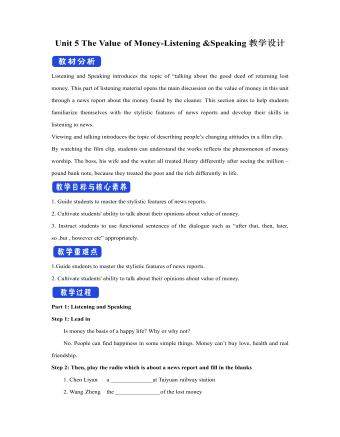
新人教版高中英语必修3Unit 5 The Value of Money-Listening &Speaking教学设计
Step 4: Listen again and decide if the following statements are true (T) or false (F).1 It was the first time Chen Liyan's story was reported. T口 F口2 Chen found 10,000 yuan in a small plastic bag in Taiyuan railway station口 F口3 Wang Zheng apologized to Chen because he couldn't offer her more money. T口 F口4 Chen took out a large loan to cure her daughter, T口 F口5 Wang set up a fundraising website for Chen's daughter after Chen told him about her situation. T口 F口Step 5:After listening, discuss the questions.1 What kind of person do you think Chen Liyan is?Chen Liyan is generous and honest because she returned a large sum of money to the owner.2 Did Chen return the money because she didn't need it?No. She returned the money because it was the right thing to do. Evidence for this is that she refused to accept the reward money because she felt that it had not been earned. 3 Is it common for people to do what Chen did?It depends on the culture. In some countries it is quite common to return money that has been found. In other countries, people believe "Finders are keepers!" 4 How did Wang Zheng feel about the return of his money?He must have been very happy and relieved to have gotten his money back. We know this because he thanked Chen repeatedly and even offered her a reward.5 Why did Ma Dongbao tell Wang about Chen's family?He must have had great sympathy for Chen and her daughter and wanted to help them.'We know this because he arranged help for them. 6 How did the news reporter feel about Chen's actions?The news reporter felt that it showed that money wasn't the most important thing in life. We know this because the reporter told us that this is what Chen believes. and then said, “that's a great attitude to take."
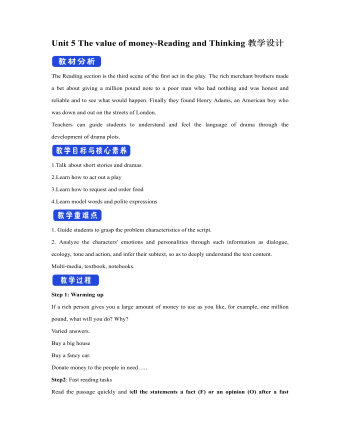
新人教版高中英语必修3Unit 5 The value of money-Reading and Thinking教学设计二
? Could you offer me some kind of work here?? I don’t want your charity, I just want an honest job.? Careless: I landed in Britain by accident.Step 7:Consolidation.? Find Henry? Roderick and Oliver were I .making a bet when they saw Henry, a poor young man. ? Know Henry? About a month ago, Henry was sailing and later he found himself carried out to sea by a strong wind. Fortunately, he 2.was spotted by a ship. And it was the ship that brought him to 3.England? Offer money to Henry ? Oliver and Roderick gave Henry a letter and told him that there was money in it. They 4.persuaded him to accept it, and made him 5.promise that it wouldn't be opened until 2 o'clock.Step 8:Language pointsa large amount of: a large quantity of; a great deal ofe.g. They bought a large amount of furniture before they moved their new house.make a bet: make an arrangement to risk money, etc. on an event of which the result is doubtful.e.g. We made a bet on the result of the match.permit sb to do something: allow somebody to do somethinge.g. My mother doesn’t permit me to ride in the street after it rained.by accident: as a result of chancee.g. I only found it by accident.stare at: look at somebody or something with the eyes wide open in a fixed gaze( in astonishment, wonder, fear, etc)to be honest: to tell you the truth; to be franke.g. To be honest, I don’t think we have a chance of winning.Step7 Homework:What do you think will happen to Henry? Will the bank-note help him or get him into trouble?

新人教版高中英语必修3Unit 5 The Value of Money-Reading for Writing教学设计二
2. 您能看到, 我头发太长了。You can see that my hair is much too long.3. 无论什么时候, 只要您想回来就回来。Please come back whenever you want.4. 您仅有很少的头发要理! You only have too little hair to cut !5. 为您服务是我的荣幸!It is my honour to serve you!Step 9 Writing(Henry is walking down the street when he sees a sign for a place that cuts hair. He decides to have it cut. )H=Henry B=BarberH: Good afternoon, I’d like to have my hair cut, if I may. (The barber looks at Henry’s hair and continues cutting another man’s hair. ) Er, I’d really like a haircut. As you can see it’s much too long. B: (in a rude manner) Yes, I can see that. Indeed, I can. H: Fine, well, I’ll have a seat then. (He sits in one of the barber’s chairs. The barber turns to look at Henry. )B: It’s quite expensive here, you know! Are you sure you can afford it?H: Yes. I think so. (After his hair is cut, the barber tells Henry how much he must pay. Henry shows the barber the bank note. )B: Why Mr. . . (looks shocked)H: Adams. Henry Adams. I’m sorry. I don’t have any change. B: Please don’t worry! (wearing a big smile) Nothing to worry about! Nothing at all! Please come back whenever you want, even if you only have too little hair to cut! It will be my honour to serve you!Step 10 Pair workExchange drafts with a partner. Use this checklist to help your partner revise his/her draft.1. Are all the elements of a play included and in good order ?2. Do the character use suitable language ?3. Are the stage directions clear and useful ?4. Is the plot clear and exciting enough ?

人教版新目标初中英语七年级下册Where did you go on vacation说课稿5篇
三、说教法只有当教师既在思想上把学生当成真正的学习主体,又在课堂教学过程中始终把学生当做学习的主人,教学目标才能实现,教学效率和效益才可能提高。因此课堂上加强对学生学习策略的指导是非常重要的,要使课堂教学过程成为师生共同参与,相互作用与反馈,创造性地实现教学目标的过程。另外,结合本节课内容特点,我还确立了“任务型”教学模式,并配合情景教学来实现教学目标。四、说学法课程标准倡导:教学要着眼于学生的全面成长,促进学生认知、情感、态度与技能等方面的和谐发展,着眼于学生潜能的唤醒,开掘与提升,促进学生的自主发展;关注学生的生活世界和学生的独特需要的有机结合,促进学生有个性,有特色的发展,关注学生的终身学习的愿望和能力的形成,促进学生特性发展。因此我确定本节课学习策略是:1、积极调动学生参与的积极性,指导学生感知,体验参与和合作。2、通过阅读,获取信息,并能回答相关问题。3、善于发现总结或把知识归类,按一定语言规律加以运用。
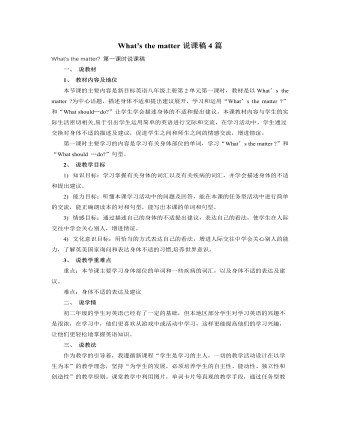
人教版新目标初中英语八年级上册What’s the matter说课稿4篇
在任务环活动中,我通过设计不同的四个任务,让学生在小组中交流、合作、竞争,每个任务都存在着一定的“信息差”,易于激发学生的表达欲望和急于知道最终结果的心情,在活动中他们一定会努力表现自己,做到最好。四个任务所侧重的训练学生的语言能力的要求也各有不同,他们分别侧重训练学生的听、说、读、写的能力。把任务活动放在小组中进行,还可以解决“大班”难于操练的难题,学生在小组中有更多的时间来运用英语表达自己的思想。Post-task任务后活动(4”)1. Grammar Focus(2”)Go through the Grammar Focus with the whole class,ask Ss to point out the main points in this period. Then show the use of The Past Tense on the screen, especially the regular and irregular changes of verbs. 2. Language practice(2”)Practise the sentence patterns and the use of the Past Tense, especially the errors which Ss made while carrying out their tasks. Such as Subject-verb agreement or Tense-agreement, etc. For example: were you see any sharks? He go to the beach. 在学生尽情地参与活动后再让学生反思本节课的语法焦点,并进行适当的操练,对学生在任务活动中的语言失误进行纠正,使学生保持学习信心。语法讲解采用动画形式又保持了学生的学习兴趣。
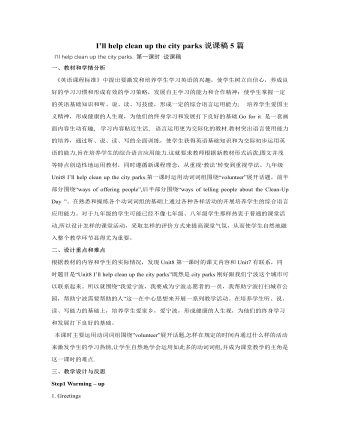
人教版新目标初中英语九年级下册I’ll help clean up the city parks说课稿5篇
二、教法学法1、任务型教学法:每个教学环节都是围绕着如何完成一个教学任务来设计的。2、感悟法:创设语境,让学生在一定的语言环境中感悟语言内涵,从而实现悟中学的目的。只有学生自己悟出的东西才能较好地内化为自己的东西。3、合作点拨法:通过教师创设的学习氛围,设置问题和反思质疑,推动师生,生生间的合作探究,小组合作学习,在解决问题中完成教学目标。以培养他们的合作探究的意识与精神。三、教学程序1 导入新课利用课件中的图片导入:在大屏幕上出示汶川大地震中一些悲惨的图片,让同学们说出汶川,然后老师说as well-know a stong earthquake happened in wenchuan,so many kind people go there to help others.再出示一些军人,医疗工作者,志愿者忙碌的身影,特别是温家宝总理看望受伤的孩子,让同学们知道一方有难,四方支持,帮助困难中的人是很有意义的。然后说Would you like to help others?What would you like to do?
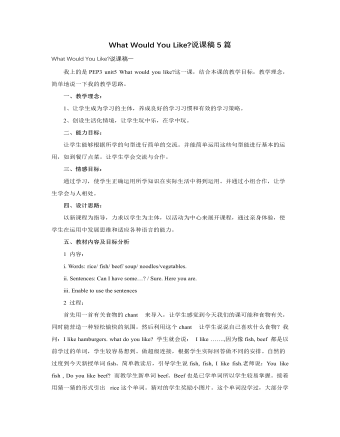
人教版新课标PEP小学英语四年级上册What Would You Like说课稿5篇
为了达到教学目标,解决本课时中的重点和难点,我进行了以下步骤的教学。首先是课前热身,我与学生进行了一些日常会话的练习,让学生进入英语学习的状态。在日常会话中,我还问到了Do you like apples/hamburgers/hot dogs/…?Yes,I do./No,I don’t.涉及到了学生在三年级时学过的一些食物、水果等。接着,我让学生猜了一些有关食物的单词,采用用手指书空和看口型猜的方法,集中学生的注意里,激发他们的学习兴趣。复习了食物单词之后,我用了三年级时学的一个Let’s do,让学生在快乐的学习氛围中投入到本节课的习。在新课呈现部分,我用Today I have more food for you.进入新课的学习。用课件出示六个盘子,请学生上来用鼠标选择,随机学习新单词,提醒学生注意单词的发音,有的单词学习的时候用已经学过的单词引出,有些则用一些用chant进行巩固教学。
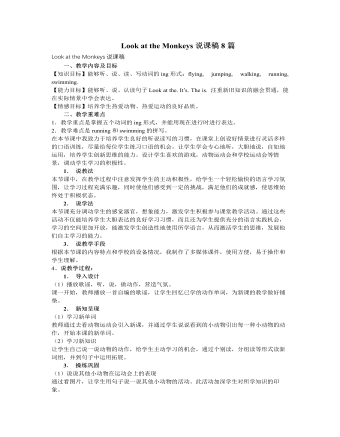
人教版新课标PEP小学英语五年级下册Look at the Monkeys说课稿8篇
四、拓展提高,评价促学1、欣赏故事。在学习完所有内容后,老师请学生继续听、看和试着说出这个童话故事的一部分,然后通过拜访几个动物的家庭,利用我们眼睛看到的事物,我举例示范了一个对话,并根据听到的内容将所缺少的单词填写进去。在原来听、说、读的基础上,增加了写的环节,真正完成了单词的四会要求。2、童话表演。这个童话故事将所有的内容综合在一起,是单词与句型的综合运用。在学生听说读写的训练过程之后,两人小组的表演培养了学生的合作学习能力,让学生们通过师生、生生、小组等不同的合作方式,学会倾听,学会评价。3、中心升华。最后,我利用小鸟的眼睛,我们一起欣赏了大千世界各种美丽的事物,让学生学习之余,能够有所减压和感受,连青蛙都喜欢上整个世界,跳出了小井,感受整个世界的美好。五、课堂小结,作业布置(1) 抄写所学的四会单词。(2)将童话剧表演给父母看。这一环节培养了学生语言的运用能力,体验学习英语的成功带来的喜悦,达到学以致用的目的。
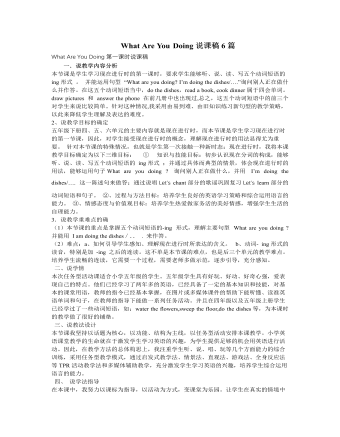
人教版新课标PEP小学英语五年级下册What Are You Doing说课稿6篇
五、教学程序:下面我结合课件谈谈本节课的教学程序: 1. 课前热身:让同学们边说边做动作。这段Chant联系了两个内容,一是现在进行时,二是We’re having a party. We are happy. 这两点都紧扣本课的两个要点。2. Revision: Are you happy? Let’s do something happy and funny. Let’s play a game. What are you doing? I’m cooking, cooking. 全班分为四组,每组代表轮流提问:what are you doing ,下一组任何一位同学快速回答I’m cooking, cooking.并做相应动作。这一游戏不只复习了大量的动词和进行时,也让同学逐渐在竞赛中趋向兴奋的状态。3. Presentation: I’m happy today, Do you know why? Because it’s my birthday today.把同学的注意力引到我的身上。Look at me. What am I wearing today? I’m wearing a skirt. I am wearing a sweater.引出今天要掌握的单词wear与句型I’m wearing…,然后提问What are you wearing? What is he /she wearing? 同学刚开始回答时可能会用I am in …..?但回答过几轮之后他们就能够正确运用Wear这个词了。
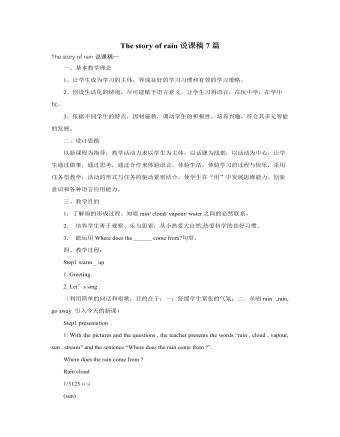
人教版新课标PEP小学英语六年级上册The story of rain说课稿7篇
4,在向学生提出了“ the water cycle”后,为了学生能够形象地解释,我马上播放flash “the water cycle”,5,通过观看flash “the water cycle”,学生已经能够理解水循环的意思,所以在理解的基础上,我出现了今天的chant,利用Chant的目的:1、记忆单词;2、熟悉新句型;3、使课堂更生动、活泼,让学生学得轻松。6,最后,播放了一个“一滴水”flash ,把本课的主题升华,让学生在一堂课中能够有所学有所悟。Water is useful(有用的). Let’s love it and protect(保护) it. Step 4 Homework在有限的时间里,通过练习作业本上的几个题目,来看看学生对本课的学习掌握了多少,同时也反馈给老师一些信息,看看本课哪些地方需要下一课时补充巩固一下。整堂课下来,自身受益匪浅,当然也发现了很多需要改进的地方,作为一个新教师,教学经验不足,课堂应变能力不强,教学用语生疏等等,希望在这里可能得到各位老师的指点和教导。
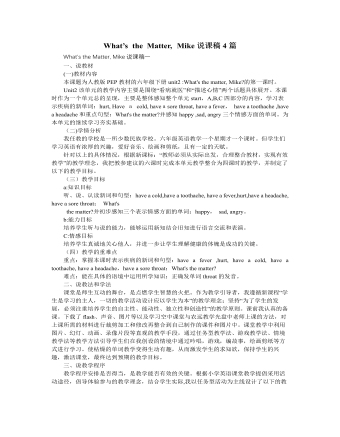
人教版新课标PEP小学英语六年级下册What’s the Matter, Mike说课稿4篇
请个别学生朗读、说出所缺字母并用肢体语言或表情说明意思。4.活动二:a guessing game利用卡片复习上节课的句型。[设计意图] 日常口语操练为学生营造了一个良好的学习氛围,英语歌曲优美动听,口语操练生动有趣,为学习新课打下了良好的基础.Step2Presentation (7 minutes) 活动三Learn the dialogue1.导看:教师用投影仪展示自己的一张旅游的照片和一张不及格的试卷,以此引出 词组a big trip, failed the math test.2.听对话录音,学生跟读。3.教师带读。4.两人一组分角色进行对话练习。5.分两大组朗读对话,对表现好的组予以表扬.6.师生就对话内容进行问答:T:Who looks happy? Why?S:Liu Yun looks happy. She is going on a big trip.T:Who looks sad? Why? S:Sarah looks sad. She failed the math test.[设计意图]使用实物展示来呈现新词组能加深学生对词组的理解和记忆.对于枯燥的句型朗读,采用多种不同的方式,如师生互动、分角色朗读,分组比赛等,避免学生产生疲劳感.
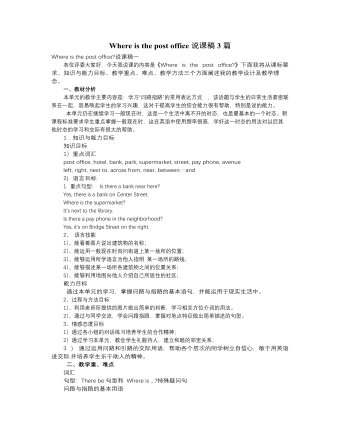
人教版新目标初中英语七年级下册Where is the post office说课稿3篇
Vocabulary:post office, restaurant, bank, supermarket, avenue, pay phone, park, dirty, clean, left, right, next to, across from, near, between, in front of, behindRecycling: hotel, street, new, big, small, busy, Do you want to…?Learning Strategies:Using what you knowDeducingPersonalizingSection ACreate plots and scenes to guide the new lessonThe main content is to learn to ask for and give directions in conversations by introducing some buildings in Section A, so we can adopt the Audiovisual Guiding Method: At first ,review the prepositions that the students have learned, then the teacher can teach some nouns about buildings by showing some pictures or projecting flashcards about some buildings.1. Show a picture of a bank.T:Look at this picture. What place is it ?S:It is a bank.T:Spell it.S: B-A-N-K .Teach other new words : post office, park, supermarket, payphone, street, .Show a map and let students practice in pairs.Is there …… ?Yes, there is. /No, there isn’t.2. Consolidation: Tell us the way to your school.T: Where is the …?S: It’s ….Teach the prepositionsNext to,across from,near,between,in front of,behind.Step1: .Learn some nouns about buildings first, and then the teacher communicates with the students.

人教版新目标初中英语八年级上册Can you come to my party说课稿5篇
二、教学设计与构思根据以上对教材的分析,同时针对学生学习外语存在一定困难的实际情况及学生的年龄特点,首先给学生营造一个温馨愉悦的氛围,创设一个接近学生生活的语言环境,激发学生的学习兴趣,让学生乐于参于以后的活动中,而且每一个环节都配有相应的动画或亲切的画面,让学生在看、听和感知中接受知识,陶冶情操。最后用清晰明了的方式总结知识要点,便于学生巩固复习。在评价学习上,采用多元化评价,尊重差异,富于感性。布置作业时,分两部分,由浅入深,照顾全体学生。三、教学文法通过五步教学法,精讲巧红,由浅入深,以学生为主体,开展师生双边活动。四、教学手段使用现代化教学手段,多媒体辅助教学贯穿整个教学过程,增加直观性和趣味性,提高教学效果。
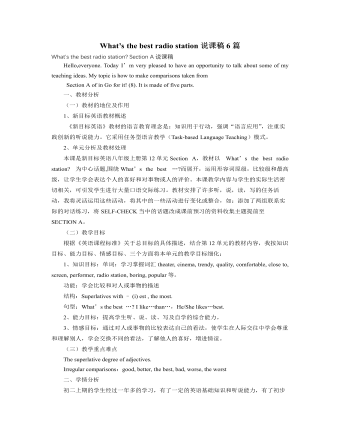
人教版新目标初中英语八年级上册What’s the best radio station说课稿6篇
3、重点和难点:重点:学会用形容词的最高级来对事物或人物进行描述。难点:形容词的最高级加est还是加most.二、 说教法:为了更好的突出重点,突破难点,我主要采用了:1、任务型教学法:新课标倡导的“玩中学,学中玩”的理念很受学生欢迎。例如,阅读文章时,我设计了一张表格,让学生阅读后完成表格并复述。培养学生逻辑分类与表述能力。2、 竞赛教学法:根据初中生争强好胜的性格特征,我每堂课都进行俩俩对话,激发学生兴趣,给学生创造外语语言氛围,培养学生集体荣誉感。三、说学法:1、 善于抓住用英语交际的机会,充分感知,积极体验,大胆实践。例如在导入新课时的One minute dialogue(每组都有一次机会),pairwork (每人都有机会),groupwork(每组一次机会)。2、 积极参与,善于合作。例如本课设计了几个任务,操作简单,学生一定很感兴趣并且积极参与,从而合作完成任务,培养了团队精神。
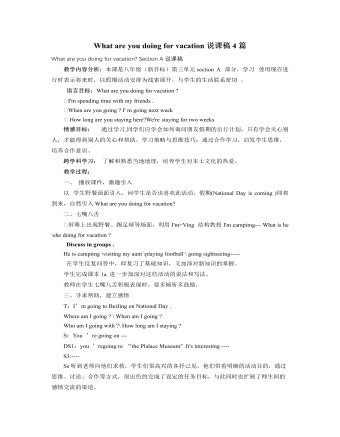
人教版新目标初中英语八年级上册What are you doing for vacation说课稿4篇
这一环节我采用电影《哈利波特》中哈利去霍格华兹的图片引入“how does Harry go to school?” 进而引入” how do you go to school?” 呈现“the ways to go to school” 让学生明确take 的使用及与交通工具的搭配。接着让学生根据实际情况回答自己采用的交通方式,期间可以引入“how does he /she go to school?” 基本了解了怎么说后进入课文,完成1a 部分练习 和1 b 的听力练习。完成后让学生玩一个数字游戏,帮学生回忆数字。通过问学生从家里出发时间和到达时间,引出“it takes ?? minutes .” 的句型。借助ppt 图片进行句型操练。然后完成听力练习2a—2c。本环节用时20分钟。While-task:本堂课的主要任务是让学生运用已学的语言知识,完成一个任务,即计算从学校到上海各种交通工具所需要的时间和费用,讨论应选用和种交通工具和各种优缺点。这一环节将用时10分钟。
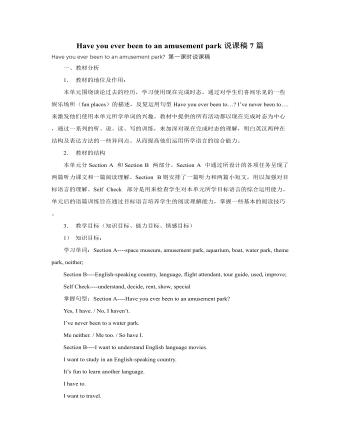
人教版新目标初中英语八年级下册Have you ever been to an amusement park说课稿7篇
1. 教材的地位及作用:本单元围绕谈论过去的经历,学习使用现在完成时态。通过对学生们喜闻乐见的一些娱乐场所(fun places)的描述,反复运用句型Have you ever been to…? I’ve never been to…. 来激发他们使用本单元所学单词的兴趣。教材中提供的所有活动都以现在完成时态为中心,通过一系列的听、说、读、写的训练,来加深对现在完成时态的理解,明白英汉两种在结构及表达方法的一些异同点。从而提高他们运用所学语言的综合能力。2. 教材的结构本单元分Section A 和Section B 两部分。Section A 中通过所设计的各项任务呈现了两篇听力课文和一篇阅读理解。Section B则安排了一篇听力和两篇小短文,用以加强对目标语言的理解。Self Check 部分是用来检查学生对本单元所学目标语言的综合运用能力。单元后的语篇训练旨在通过目标语言培养学生的阅读理解能力,掌握一些基本的阅读技巧。3. 教学目标(知识目标、能力目标、情感目标)
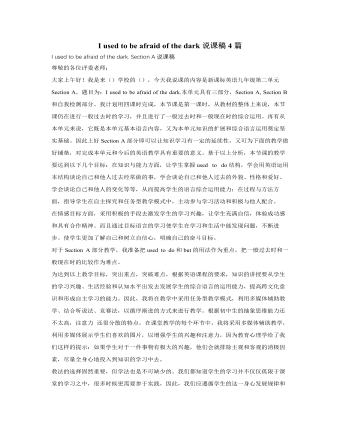
人教版新目标初中英语九年级上册I used to be afraid of the dark说课稿4篇
2、说说写写通过读写训练,进一步学会用 used to 结构来表达自己和同伴过去害怕,或现在仍旧害怕的事情,并且要把最后的结果书写下来,然后让他们将结果用英语告之其他同学,为学生创造展示才能的机会。这样能使全体同学都积极参与,集中精力认真听。既巩固了本节课的目标语言,又为下一个环节3b的对话打下基础。活动结问题比较容易,英语基础较差的学生也能够独立完成,因此,在检查答案是尽量让这部分学生回答,使他们体验到成功后的喜悦,提高他们学习英语的兴趣。 3.对话练习:让学生两人一组,模仿3a中的对话,根据提供的信息与提示词进行对话练习,目的在于对新学的目标语言进行口头练习与设定情景中的运用。为学生创造展示才能的机会。推荐两至三组的同学到教室前面,就所编的对话进行角色表演。
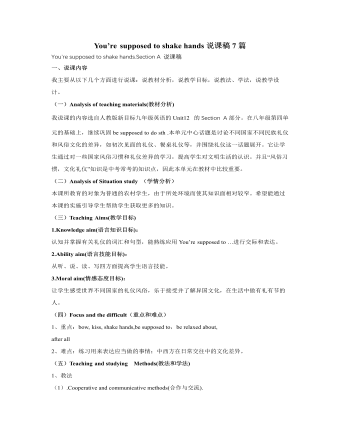
人教版新目标初中英语九年级下册You’re supposed to shake hands说课稿7篇
二 、教材分析本单元主要是通过对一些国家的风俗习惯、礼仪差异、时间观念和饮食文化的学习,进一步提高学生对文明生活的认识;加深学生对中外文化的了解,拓展学生的文化视野,为学生阅读相关方面的文章奠定一定的文化基础。我们知道近几年来有关风俗文化,生活习惯的 阅读内容一直是中考热门的话题之一。通过本单元的学习,学生可以掌握一定的相关方面的知识,为今后在阅读积累必要的信息。在Section A 当中出现的 be supposed to 句型为重点句型,此句型的语法结构为被动语态。被动语态也是历年来中考基础命题必考的内容之一。比如,去年的中考试题,在基础选择部分试题中就出现了对此语法结构考查。Section A 首先通过一些图片和句型来让学生初步了解本单元的语言目标。然后,通过练习进一步加以巩固。接着通过一组听力练习,来训练学生的听力,同时,学生可以具体了解到不同的国家在风俗习惯等方面有着怎样的不同。为下面的学习进行铺垫,同时激发学生了解更多的相关知识的学习兴趣。
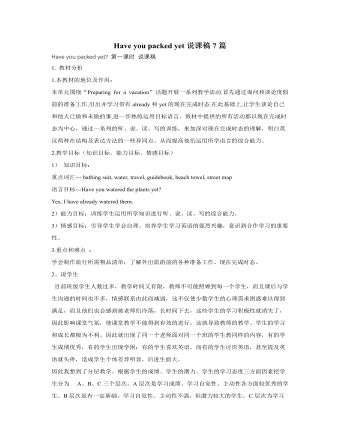
人教版新目标初中英语九年级下册Have you packed yet说课稿7篇
二 说学情 “以学生的发展为本”的新课程理念,要求教学必须以学生的学习基础、学生需要、学习兴趣等为出发点,联系学生的现代校内外生活,让课堂教学成为学生生命成长和个性张扬的过程。要实现以“学生为本”的理念,教学中必须要做到充分地预设学情。初三学生已经具备了一定的语言基础及语言表达能力,大部分学生对英语还有着比较浓厚的兴趣。同时,在长期的新课程理念熏陶及实践中,已经初步具备了自主,合作,探究的能力。本课教学内容与学生的实际生活密切相关,易于引发学生运用简单的英语进行交际和交流。通过八年级下册第九单元“Have you ever been to an amusement park?”的学习,学生已初步了解现在完成时的基本特征和结构,也比较熟悉“has/have been to…”的句型,这非常有利于本单元教学活动的开展。在此基础上,本单元以“Preparing for a vacation”和“Favorite band”等贴近学生实际生活的内容为话题,继续学习带有already与yet的现在完成时态,较快地激发学生的学习积极性,达成本单元的教学目标。